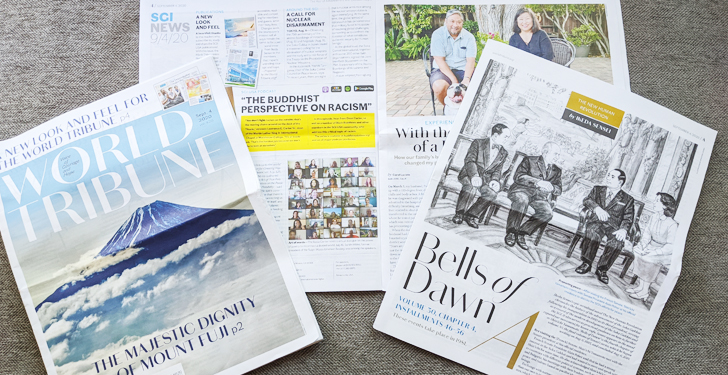It is through the use of words and letters that the Buddha saves living beings. … If one rejects the use of words and letters, then how can the Buddha’s work be done? (“Letter to Renjo,” The Writings of Nichiren Daishonin, vol. 2, pp. 6–7)
Nichiren Daishonin studied the vast body of Buddhist sutras, among other historical and literary works, concluding that the heart of Shakyamuni Buddha’s teaching lies in the principle that the life condition of Buddhahood is inherent in all life (see The Lotus Sutra and Its Opening and Closing Sutras, pp. 265–73).
While the teachings of many Buddhist schools in 13th century Japan were often inaccessible to common people, Nichiren strove to make the Lotus Sutra understood by all. As an example, the Daishonin criticized the Zen school for using “a separate transmission outside the sutras, independent of words or writing” to convey the Buddha’s teaching (see WND-2, 6). The school claimed that the Buddha’s enlightenment is transmitted from the mind of one Zen patriarch to the next.
Nichiren, on the other hand, emphasized the importance of transmitting the Buddha’s teachings using the written and spoken word. He wrote countless letters to encourage his disciples and to leave a record of correct Buddhist faith for posterity.
In addition, he named the Buddha nature inherent in all life Nam-myoho-renge-kyo.
Because it is extremely difficult to express the eternal and universal Law with a painting or carving, Ikeda Sensei explains, the Daishonin inscribed the Gohonzon in script (see December 2011 Living Buddhism, p. 47).
“Words and letters” powerfully express the deep wish of the Buddha to lead all people to enlightenment. Nichiren asserts that the “Lotus Sutra is the truest of true words, and the truest of truths” (“The Importance of the Moment of Death,” WND-2, 760).
SGI Publications Infused With the Buddha’s Vow
Since its establishment in November 1930, the Soka Gakkai has remained true to the Daishonin’s vow to ensure that the Buddha’s teachings can be accessed by all people.
On April 20, 1951, Josei Toda launched the Seikyo Shimbun, the Soka Gakkai’s daily newspaper. Sensei says, “Enlightening the people, strengthening the people, unifying the people—that has been the mission of the Seikyo Shimbun from its inception” (Aug. 17, 2018, World Tribune, p. 3). This is the mission shared by the SGI publications across the globe.
In April 1952, the Soka Gakkai published the Gosho zenshu (The Complete Writings of Nichiren Daishonin), based on Mr. Toda’s conviction that the only way to realize kosen-rufu is to have each member engrave Nichiren’s writings in their lives and establish resolute faith (see April 2017 Living Buddhism, p. 24).
With the practice of chanting Nam-myoho-renge-kyo to the Gohonzon, and studying and sharing the Daishonin’s writings and our SGI publications, Nichiren Buddhism has spread widely throughout the world.
Sensei wrote the following in his message to the 50th anniversary of the World Tribune:
“If one rejects the use of words and letters, then how can the Buddha’s work be done?” (WND-2, 6–7).
In the passage above, “words” refers to the sutras. But one could say that the World Tribune—a publication of kosen-rufu that correctly teaches Buddhist ideals and conveys the SGI’s movement for peace, culture and education—is a newspaper that does the Buddha’s work through the power of the written word. (Sept. 5, 2014, World Tribune, p. 1)
Through our efforts to share “the truest of true words,” we are directly connecting to Nichiren’s teachings and carrying out the work of the Buddha to empower all people in developing lives of unshakable happiness and peace. The benefits gained through such efforts are boundless and everlasting.
—Prepared by the SGI-USA Study Department
You are reading {{ meterCount }} of {{ meterMax }} free premium articles

